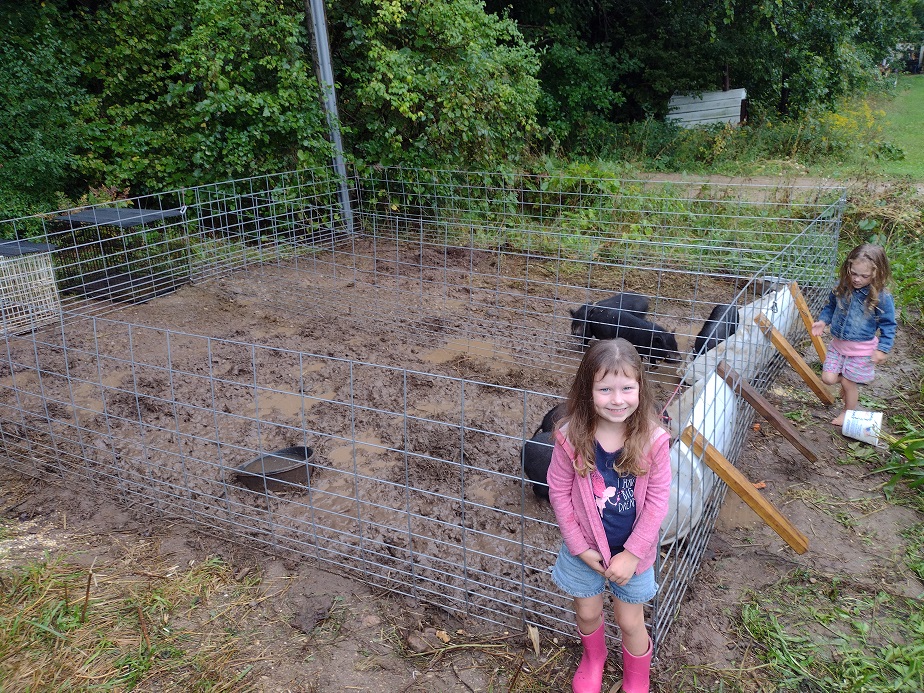A good pig pen is a lifesaver if you want to raise pigs. I really can’t stress that enough, a bad pigpen will give you problems.
The best material for a pig pen is either hog panels and strong posts, or a stout electric fence. The standard size is a 16-foot square, but larger pastures are beneficial. The necessary strength of the pigpen depends on the breed of the pigs, and whether or not you will keep breeding stock.
Let’s talk about the different designs and styles you may need, and just how much it will cost you.
Building a Pig Pen
There are three primary pig pens; the boar pen, the sow pen, and the feeder pen. The latter is the most common so let’s cover that first. A feeder pig is a weaned piglet that you will be feeding out to butcher and not keeping as a pet or breeder. Most pigs purchased are as feeder pigs.
This is your classic pig pen, and the simplest one to set up. It doesn’t have to be permanent. It can be fairly mobile or even taken down completely after they’re butchered, usually around 6-8 months old.
There’s basically two styles, the pig pasture and the confined pen. I use a spacious outdoor pen for my feeders. I am against pigs being raised indoors without access to sunlight and fresh air, so I’m not going to cover the modern hog barn-type setup. I frankly don’t believe in doing it that way.
To build the more classic pig pen, I recommend hog panels and t-posts. It’s a very simple, strong, and quick-to-set-up pig pen. If you’re raising just one standard-sized hog (weighs at or over 200 pounds at 7 months), I’m happy with a 16×16 pen. That would be four panels arranged in a square.
Personally, I strongly recommend a smaller breed hog for homestead use. The potbelly pig is my favorite. Due to their size, I will put 5 weaned potbellies or one adult in a 16×16 pen and they need only the most basic of enclosures. Here’s a video of the pen I’ve raised out 5 litters in.
Make sure to get hog pannels, not cattle pannels or general livestock pannels. Hog panels are shorter, stouter, and have smaller spaces in them. Small pigs can run right through the lower section of a cattle panel. Hog panels are a must.
For me, I don’t always stake down my pig’s pen if I’m just raising young ones in it. I haven’t had a pig under 6 months old ever actually lift up a free-floating pen. Again, I raise small-breed pigs. You can’t do that with big pigs. My larger feeder pigs (up to 9 months) only need 4 t-posts for a 16×16 pen.
Supplies for a Pig Pen:
- four 16-foot hog panels
- eight 6-foot t-posts
- t-post driver
- strong wire or 32 t-post clips (bailing twine can work if needed)
- functional shelter from wind, rain, and snow.
- bowl or trough for water and feed
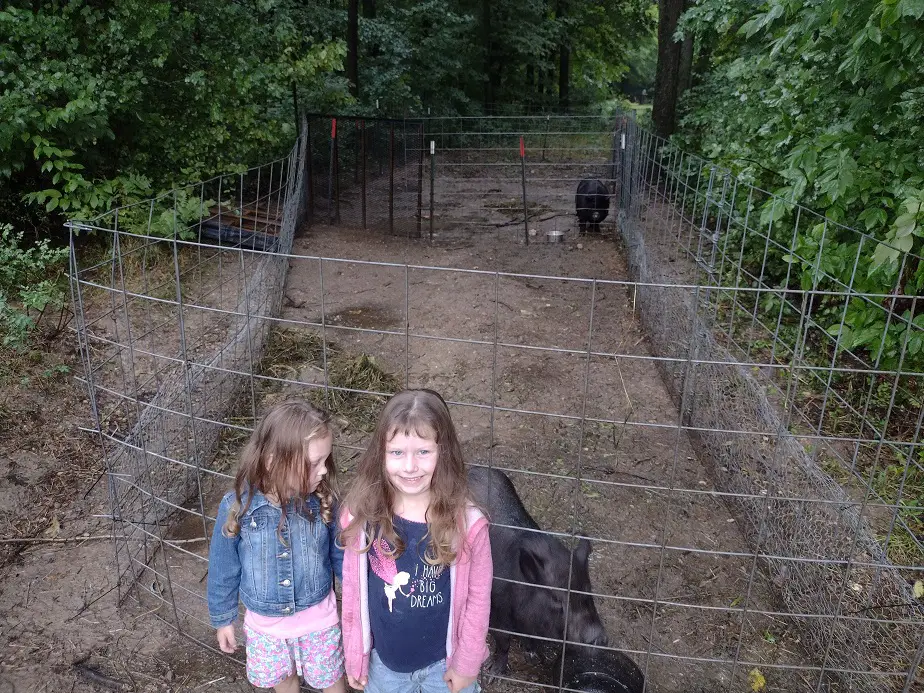
Panels and t-posts can be purchased from your local farm supply store. They can be easily transported by bending in a U-shape and placing them in the bed of a pickup and tying them down. They’ll straighten up decently afterward.
I transported my panels tied onto the luggage rack of my minivan with a 12-foot board underneath so they didn’t sag too low. It worked fine.
I strongly recommend buying or borrowing a T-post driver for the job. it’s either that or a sledge hammer and the hammer is a lot harder to work with.
I used steel carabiner clips to attach the corners of my pen. That way I can easily unhook a corner and open it up to bring in a wheelbarrow for manure collection. Pretty smart move I say.
The biggest problem with a pig pen is keeping it clean. Cleanliness is paramount for keeping disease and parasites in check. The best way to keep things clean is to remove the manure regularly and to operate on some sort of rotational system. That can be done very easily.
For example. If you had 2 pens attached to each other, you could move your pigs from one to the other every couple weeks. That would give you time to really clean one, and let the soil rest for a period. Filth is the main incubator of all sorts of diseases.
It has been shown to greatly reduce the prevalence of worms if you give the soil a 16-day resting period at some point, The more often the better. One of my favorite pig pen designs is a simple 32-foot square split up into four 16-foot squares. in this setup, rotate pigs to a new section every week. If you want simple and compact, yet clean and healthy, that’s the best sort of way to do it.
Need to know how big to make a pig pen? Read this article: How Much Space for 1 Pig? (pig pen tips)
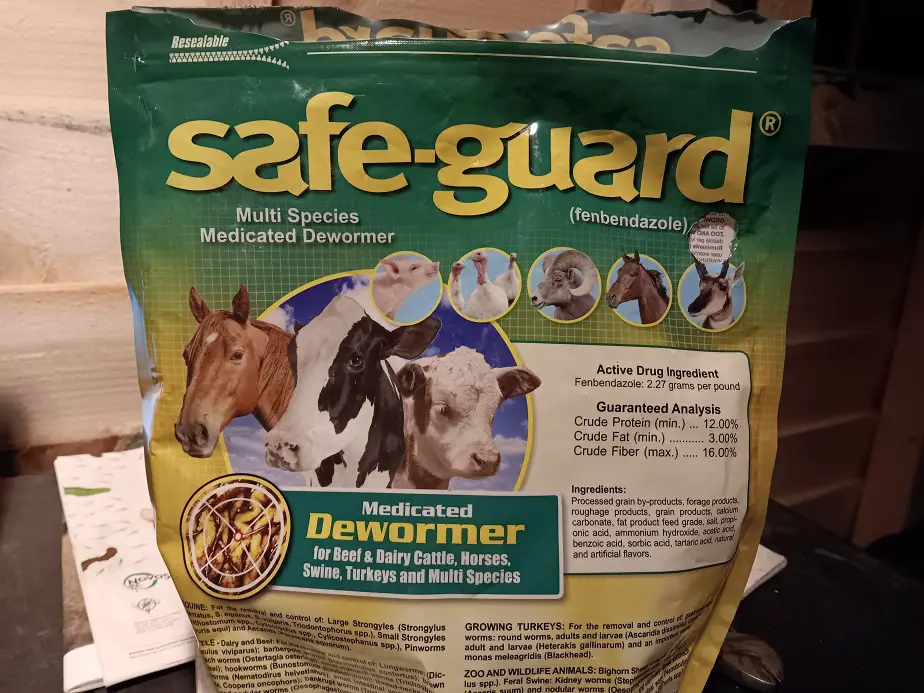
One thing you need for pigs, no matter your raising system, is a parasitic worm treatment. The best swine dewormer is Fenbendazole. It’s known by the brand name Safeguard. Safeguard is available as a medicated corn/alfalfa pellet. It’s the only way I can worm my pigs since they won’t stand still for an injection of Ivermectin. It’s easy and cheap.
- There is a stronger pellet for swine only. Here it is on Amazon
- There is a weaker pellet for general barnyard livestock, including swine. Here it is on Amazon.
I use the multi-species version because it’s what’s available in my local store and I can use it for my chickens too. It’s the most effective swine wormer and the easiest to administer. I use it on all weaned piglets and adults twice a year. Don’t go without it.
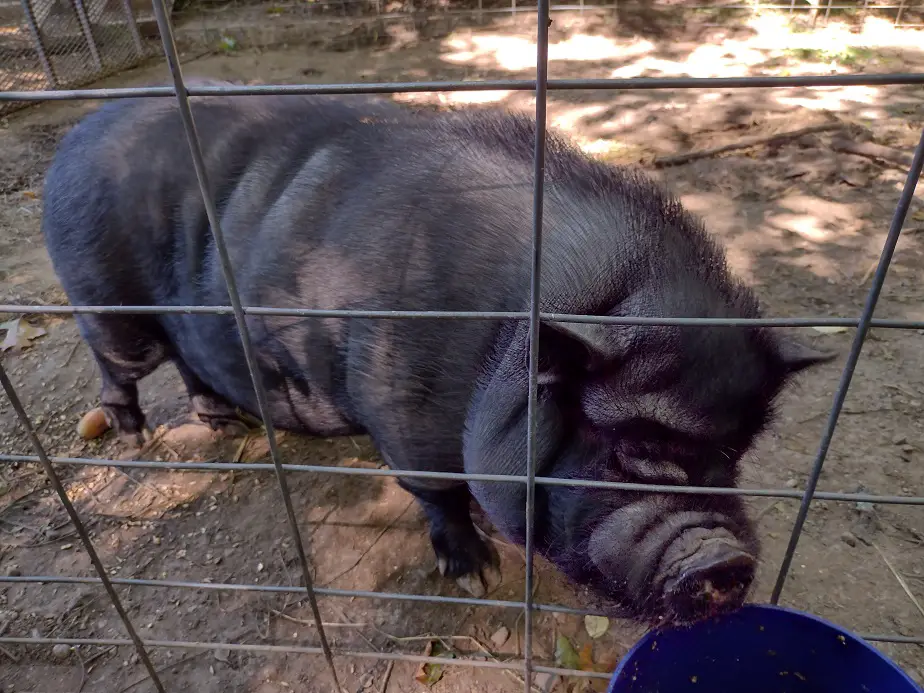
Building a Boar Pen
Boar pens must be spacious and very strong. Common methods are either a hi-potency electric fence or reinforced hog panels with heavy wooden posts. A large boar will walk right through a feeder-style enclosure. Take care when building a boar pen. Don’t cut corners anywhere or it will cost you.
If you want to keep a mature boar for breeding, you’ll need a stout pen. The average full-sized farm boar is around 500 pounds. They can reach 1,000 pounds. That’s why I like small-breed hogs. Our potbellies will max out at around 200. That’s a lot easier to keep contained.
Even then, when my mature boar notices a sow in heat, he’s awful hard on the fence and has gotten out several times by getting his snout under the pannel and uprooting a T-post. Since we raise a small-breed hog, I just use panels and t-posts. His pen is actually cattle panels with 7-1/2 foot T-posts every 8 feet.
I would have used hog pannels, but found a super deal on used cattle pannels nearby. They work for my boar. My pigs are all on dirt with no concrete in the pen.
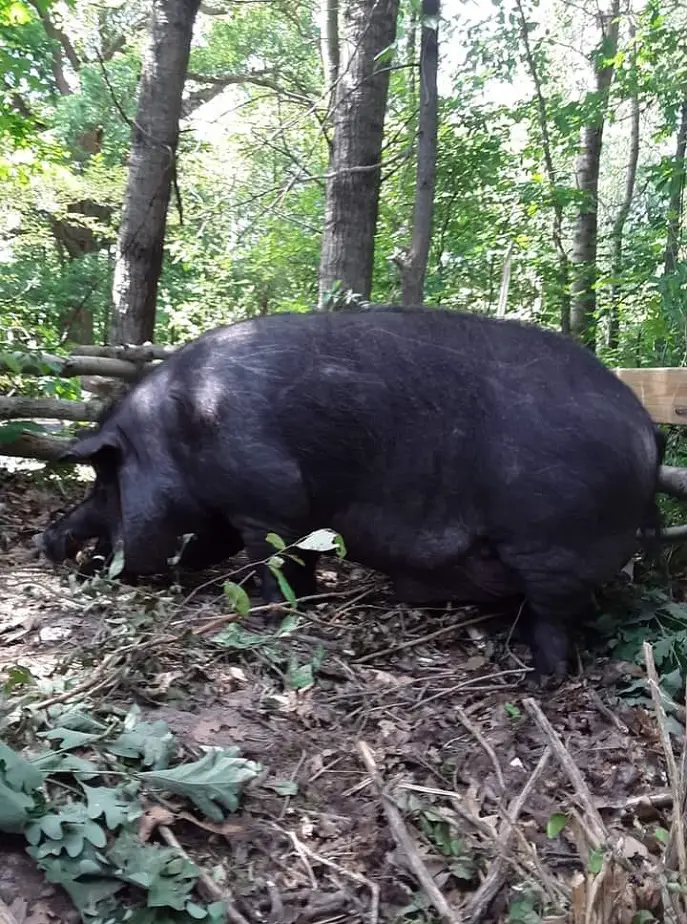
With large breeds, a lot of folks like to pout a concrete footing around the edge of the pen and set the bottom of a panel in it. This reinforces the panel and keeps the boar from rooting his way out. But, because the panel is now shorter, it needs a board at the top.
If you were to run a single strand of strong electric fence around 6-8 inches from the ground, it will pretty much keep the pig from ever thinking about getting out. I know several people who only use electric fencing to contain their pigs. They say if you train them to it young, pigs will always respect the electric fence, until it turns off. And they can tell.
The guys who raise the big pigs all say that electric is best, as long as it’s potent and you keep it well-maintained and operational. Electric fencing is by far the cheapest option for a large pen or paddock/pasture setup. If you’re building just a smaller pen, electric and panels cost about the same.
One homesteader I know made a new pig pen with large round wooden posts in the corners, a treated 4×6 along the bottom, and a hog panel on top of that. The panels had a 2×12 treated board across the middle and a treated 2×6 across the top. He’s thinking about adding a strand of electric to the inside.
I prefer to have my boar pen right up against the sow pen. That way it’s easier to get him and her together for breeding, and they’ll let me know when it’s breeding time. If I had the space, I would have multiple large paddocks to run my pigs through. That would be a good situation for electric fencing.
Electric is often less than a tenth the cost of traditional post and woven wire pasture fence. If you have a large area with access to electricity, it’s the way to go.
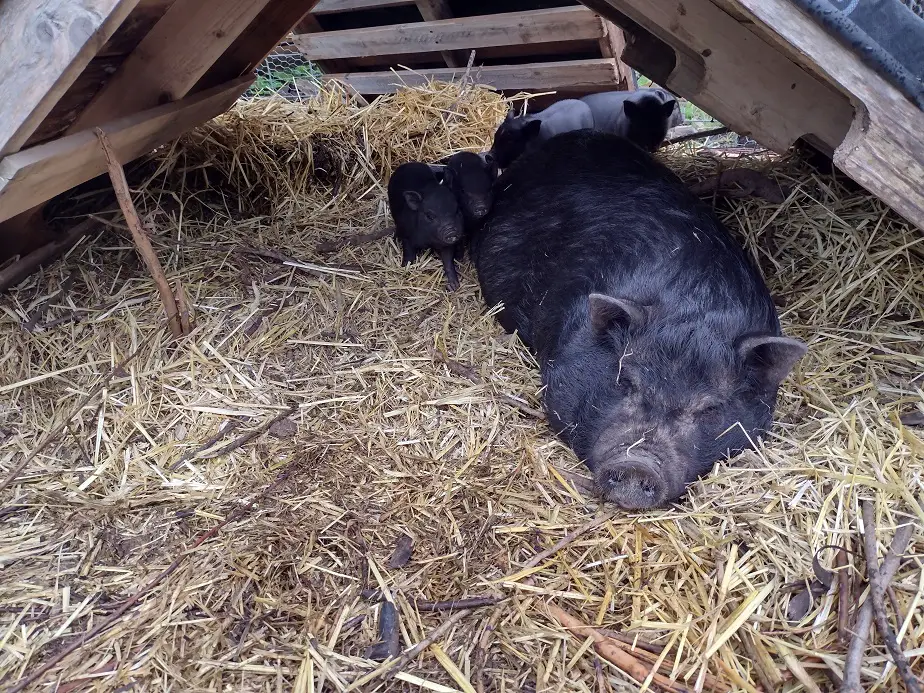
Building a Sow Pen
A sow pen doesn’t need to be as strong as a boar pen. Most sows don’t try to get out as long as their space is clean and they are well cared for. My 2 sows are kept in a 6,400 square foot (80×80) paddock in the woods. It’s a shorter woven wire fence with t-posts every 8 feet.
They have good shade, and plenty of space for them to both have litters at the same time without getting into each other’s way. If I had large-breed hogs, That may not be enough space for two mommas to get along in. Another plus for the small homestead hog. I will put a third sow in there this fall.
More about breeding, and caring for piglets in these articles:
- How to Breed Pigs
- What Age to Breed Pigs
- How to Prepare for Piglets
- What Season Are Piglets Born?
- How to Tell if Your Pig is Pregnant?
The main concern for a sow pen is that it must be piglet-proof. Piglets start small, especially from the small breeds like potbellies and kunekunes. I have not seen a baby piglet get through a hog panel, but I did have an older one climb through the middle once. Pigs attempt crazy things when riled. Do keep them calm will ya?
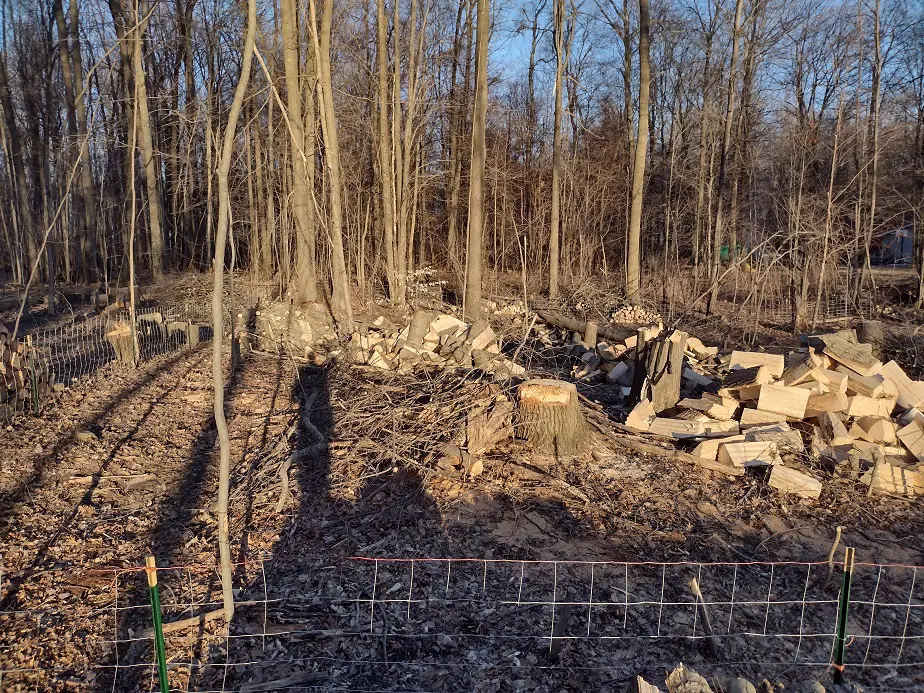
I have 9 three-week-old piglets in my sow paddock right now. Not a single one has gotten out, which almost impressed me. I did learn that the fence is not boar-proof. Ol’ Joseph busted out of his pen and went to visit his ladies. He let himself in and out.
Boars are bull-headed when around sows. Especially when a sow is in heat. Good thing my sows don’t get that way. Those girls are quite content to stay in the paddock and never have tried to go under the fence.
Related Articles:

